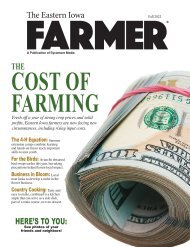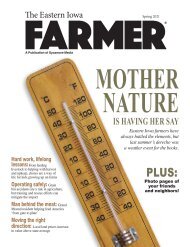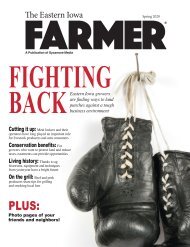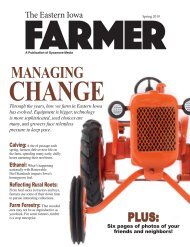Eastern Iowa Farmer Fall 2020
You also want an ePaper? Increase the reach of your titles
YUMPU automatically turns print PDFs into web optimized ePapers that Google loves.
Derecho!<br />
what in the<br />
On top of everything else that has happened in <strong>2020</strong>,<br />
in August hurricane-force winds struck yet one more blow<br />
BY Nancy Mayfield<br />
eastern iowa farmer<br />
When a derecho swept<br />
through the Midwest<br />
Aug. 10, <strong>Eastern</strong> <strong>Iowa</strong><br />
was in the path of the<br />
storm.<br />
Hurricane-force winds left downed<br />
corn, damaged grain bins and headaches<br />
about insurance, plant disease and harvest.<br />
“A swath of damage from Benton<br />
County through portions of Linn, Jones,<br />
Cedar and Clinton counties is consistent<br />
with intermittent straight line winds in the<br />
100-130 mph range,” the National Weather<br />
Service reported just days after what<br />
it called the “roughly once-in-a-decade<br />
occurrence in this region.”<br />
The last derecho was in 2011 and,<br />
before that, 1998.<br />
“What is unique about this event,<br />
making it even more extreme, is the long<br />
duration of high winds. Many locations<br />
experienced sustained high winds and<br />
damaging gusts for 30 to 45 minutes,” the<br />
weather service said.<br />
Concerns about the condition of crops<br />
and how it will impact harvest equipment,<br />
yields and profitability are at the top of<br />
the minds of farmers in <strong>Eastern</strong> <strong>Iowa</strong><br />
counties whose fields were among the<br />
3.57 million acres of corn and 2.5 million<br />
acres of soybeans in <strong>Iowa</strong> that took the<br />
worst of the summer squall.<br />
Local farmer Bob Bowman said the<br />
damage varies in fields, and it’s not<br />
always visible to someone passing by the<br />
crops on a highway or gravel road.<br />
“When you drive by, it doesn’t look<br />
bad. But if you try to walk through<br />
Photo from <strong>Iowa</strong> Corn livestream courtesy of <strong>Iowa</strong> Capital Dispatch<br />
U.S. Agriculture Secretary Sonny Perdue, at a tour in Radcliffe <strong>Iowa</strong>, signs a USDA disaster<br />
declaration for 18 <strong>Iowa</strong> counties on Sept. 3.<br />
those fields, they are impossible to walk<br />
through,” said Bowman, who is a past<br />
director and is still active in the National<br />
Corn Growers Association.<br />
<strong>Iowa</strong> Secretary of Agriculture Mike<br />
Naig noted the triple whammy of the<br />
derecho and drought that the state has<br />
weathered along with markets upset by a<br />
pandemic.<br />
“This is an unprecedented situation<br />
on top of another unprecedented situation,”<br />
he said in an online presentation<br />
organized by the <strong>Iowa</strong> State University<br />
Extension and Outreach office in late August.<br />
COVID-19 supply-chain disruptions<br />
on top of weather events are starting to<br />
compound stress on farmers.<br />
U.S. Secretary of Agriculture Sonny<br />
Perdue toured <strong>Iowa</strong> just before Labor<br />
Day and designated 18 <strong>Iowa</strong> counties<br />
as primary natural disaster areas. Cedar,<br />
Clinton and Jones counties were among<br />
those that became eligible to apply<br />
for emergency USDA loans after the<br />
120 <strong>Eastern</strong> <strong>Iowa</strong> <strong>Farmer</strong> | fall <strong>2020</strong> eifarmer.com
















